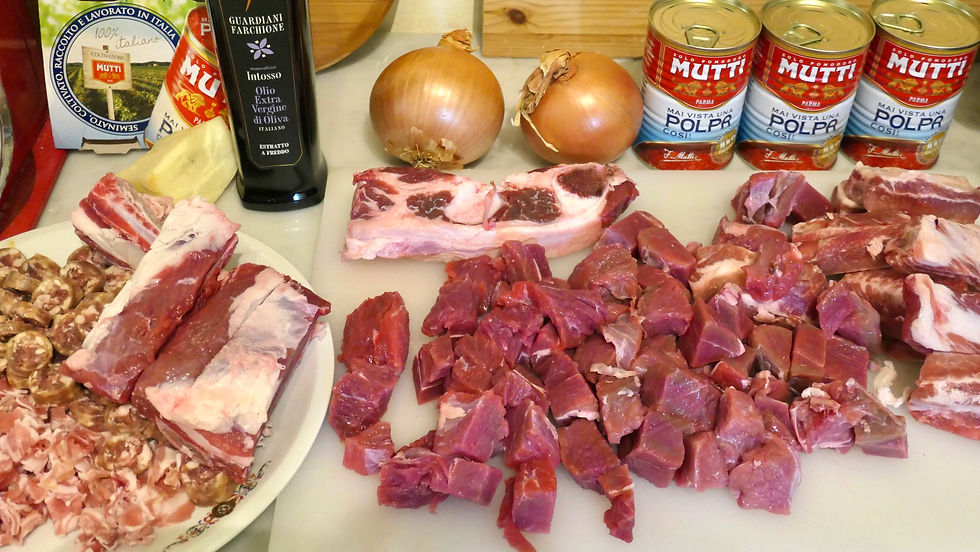Ragù Napoletano
- Mike
- Jan 4
- 4 min read

Ragù Napoletano is a very different ragù to the Bolognese version and is the very definition of slow cooking. With Bolognese the beef and pork are already ground so 3 hours of simmering is enough time but ragù Napoletano is made from a variety of collagen rich bone-in meats and tough, muscular cuts of beef that require at least 8 or 9 hours on the barest simmer possible - pippiare is how they describe this very slow simmer in Naples - to extract all the flavors.
Neapolitan restaurants will often keep a huge cauldron of ragù going for as long as 24 hours so there are no shortcuts with this recipe. And in the famous 1990 Sophia Loren film Sabato, Domenica è Lunedì, which was set in Naples, this ragù has a significant role in the film starting with a discussion in the butcher's shop as to exactly which cuts of meat should be used in the recipe.
As my good friend from Naples told me as he was tucking into this dish in my kitchen, ragù Napoletano was traditionally the centerpiece of Sunday lunch for Neapolitans and therefore it had to be prepared Saturday evening and then allowed to simmer through the night so it could be ready in time for lunch on Sunday.
Given how long it takes to make properly it's well worth cooking a huge amount and then freezing it because if anything it actually improves over time.

Approximate ingredients for at least 10 generous portions:
0.5 kilo biancostato (beef short ribs on the bone)
0.5 kilo punta di petto (bone-in beef brisket cut from the bottom of the neck to under the ribs)
0.75 kilo muscolo di manzo (boneless beef shoulder or chuck)
0.75 kilo puntine di suino (baby back pork ribs)
100 grams pancetta (pork belly, unsmoked only)
100 grams fresh young pecorino cheese (not pecorino romano) cut into small pieces
3 pork sausages
o.75 kilo yellow onions, finely diced
1.5 kilos passata di pomodoro (or canned skinless tomatoes)
3 or 4 tablespoons of tomato concentrate
200 grams/ml of red wine
Extra virgin Italian olive oil
Salt and pepper
Paccheri or Ziti pasta
Notes:
1. None of the above quantities should be viewed as exact measurements, especially with regard to the various cuts of meat because substitutions can be made like adding pork shank or using less brisket or more short ribs etc.
2. Serious restaurants in Naples will often add braciole, ie flat pieces of top round beef rolled up with cheese, parsley, pine nuts and raisins inside, then tied with string and added to the stockpot to cook slowly. They then serve just the sauce with the pasta for the primo piatto and the meat and braciole are eaten separately as the secondo piatto.
3. In the opinion of my Naples friend, Paccheri rather than Ziti is the perfect pasta for a ragù Napoletano, especially when the meat has been taken off the bone. Paccheri is such a large pasta shape that the thicker sauce and pieces of meat can easily fill the pasta and furthermore paccheri is very much a local Naples pasta made in nearby Gragnano.
4. The total cost in Italy for all of the above ingredients was less than 35 euros so it is a very cheap meal when divided by 10 portions.

Directions:
1. Trim some of the thick fat cap from the various pieces of beef and remove the membrane from the pork ribs.
2. Separate the beef and pork rib racks into individual ribs, chop the boneless meat into large chunks, chop up the sausages and pancetta and dice the onions. Season the meat with salt and pepper.
3. Use a large frying pan to (i) gently sautè the onions in olive oil without browning (then remove to a tall stockpot) (ii) render the fat from the pancetta, add some olive oil and brown all the meat and sausages sequentially so as not to crowd the frying pan and add each portion to the stockpot when sufficiently heated and browned (to facilitate the Maillard reaction).
4. When all the meat and onions are in the stock pot, deglaze the frying pan with the wine on high heat to allow the alcohol to evaporate and then add to the stockpot.
5. Add the pecorino cheese, all the passata di pomodoro, the tomato concentrate and bring to a boil and then immediately reduce the heat to a very low simmer. Add salt and pepper.
6. Leave the stockpot partially covered for about 7 hours on a simmer setting so that only the occasional bubble comes to the surface. Stir every half hour or so.
7. When the meat is falling off the bone remove all the bones from the stock pot and resume the slow simmer for about another 2 hours adjusting the lid to facilitate evaporation or adding a little water if necessary so the ragù begins to develop the correct consistency for a pasta sauce, ie not too dense but not soupy either.
8. After a couple more hours the sauce should be ready but at this point, as long as the heat remains very low, precise timing is obviously not very important.



